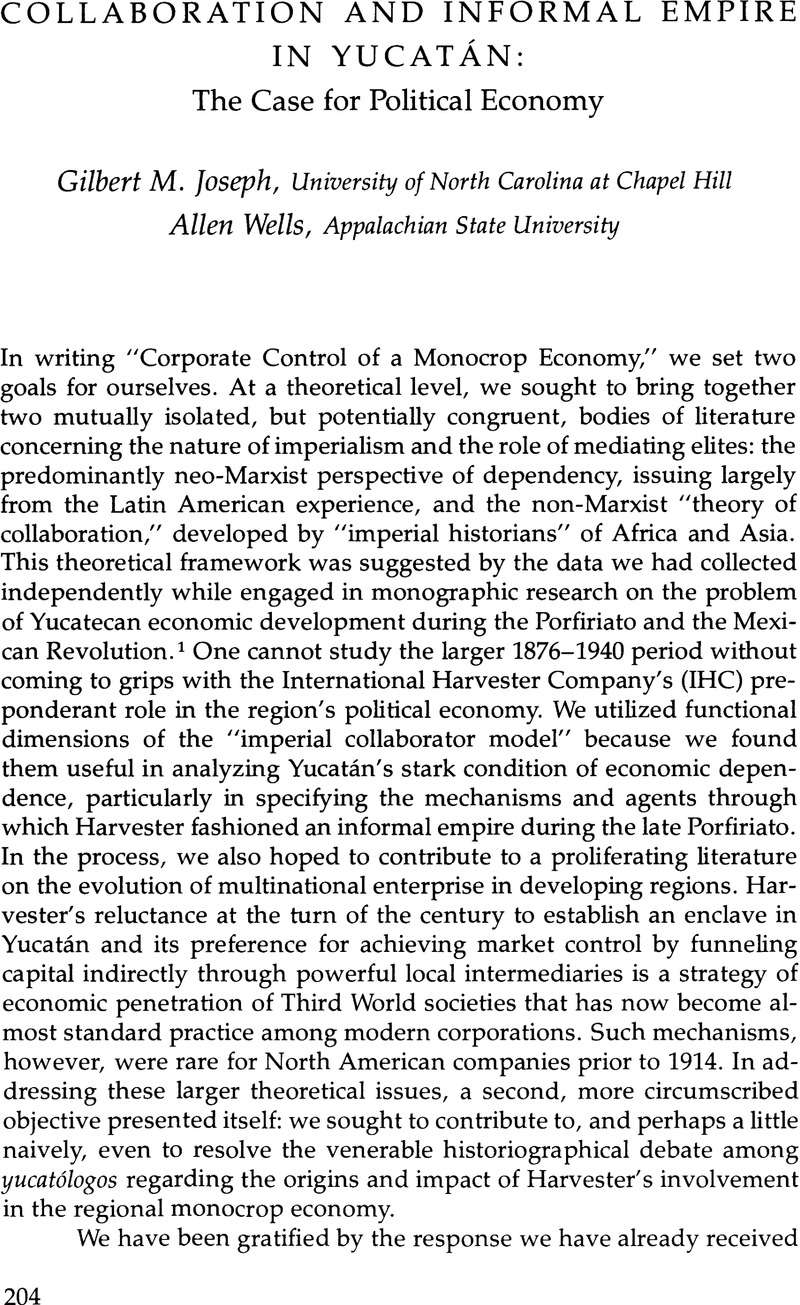Published online by Cambridge University Press: 24 October 2022

1. The results of this monographic research are found in Gilbert M. Joseph Revolution from Without: Yucatán, Mexico and the United States, 1880-1924 (Cambridge and New York, 1982); and Allen Wells, Yucatán's Golden Age: Haciendas, Henequen, and International Harvester, 1860-1915, forthcoming, University of New Mexico Press.
2. Eulalio Casares is a perfect case in point of the planter mentality at work. In 1894, amidst a recession in the world fiber market and on the verge of bankruptcy, Casares started cultivation of a new plantel (henequen field) called Santa Raquel on his hacienda Santo Domingo Xcuyum. Eighteen hundred mecates (one mecate equals 400 square meters) of henequen were planted in the face of scandalously low fiber prices. Casares similarly had planted henequen matas in planteles Santo Domingo and Road to Chí (1000 and 219 mecates, respectively) in 1887, during another lull in fiber prices. The expansion of Xcuyum continued unabated, regardless of the economic climate, precisely because Casares could extract at least some return on the most meager of prices. Far from being an isolated instance, Casares's actions characterized the prototypical henequenero. See Wells, “Henequen and Yucatán: An Analysis in Regional Economic Development, 1876-1915,” Ph.D. diss., State University of New York at Stony Brook, 1979, pp. 239-40.
3. Cuadro: publicaciones de la Cámara Agrícola de Yucatán sobre exportaciones (rectificadas), copy given to Wells by Victor M. Suárez Molina.
4. Manuel Dondé y Compañía in fact went bankrupt in 1895 as a direct result of the NCC failure, and Eusebio Escalante e Hijo never fully recovered from the attempted corner. Escalante's casa stayed in business until the next lull in henequen prices during the 1907-8 panic. See Testimonio de escritura de transacción celebrada entre el síndico de la quiebra de los Sres. M. Dondé y Cía. y el Sr. D. Manuel Dondé Cámara (Mérida, 1895); and ¿Cuál es el valor y cuál el alcance de la convención que se dice ajustada, entre la Sociedad E. Escalante e Hijo y sus acreedores? (Mérida, 1911). On the NCC corner, see Arthur S. Dewing, A History of the National Cordage Company (Cambridge, Mass., 1913); and Cordage Trade Journal 6, 1 (January 1, 1893):15.
5. For examples, see Joseph, Revolution from Without, chapters 2 and 3; Wells, “Henequen and Yucatán,” chapter 6; Friedrich Katz, “El sistema de plantación y la esclavitud,” Ciencias Políticas y Sociales 8 (1962): 103-35; and “Labor Conditions on Haciendas in Porfirian Mexico: Some Trends and Tendencies,” Hispanic American Historical Review 54, 1 (Feb. 1974):14-23.
6. Contrary to the image of an industrializing society conjured up by our critics, manufacturing was limited to several factories (ice, beer, candy, cigarettes, glass, and cement)—all modest by national standards—and the small decorticating operations on the estates themselves. See Joseph, Revolution from Without, p. 86 and p. 327, n. 40.
7. Joseph, Revolution from Without, pp. 39-40; Wells, “Henequen and Yucatán,” chapter 3.
8. The most authoritative and respected work on the henequen industry is by Yucatecan historian Gonzalo Cámara Zavala. His price series for sisal fiber indicated a steady decline in prices during the 1902-10 period from a high of 9.8 cents a pound in 1902 to 4.25 cents a pound in 1910. These statistics mirror our sources and they closely approximate Benjamin's data. Cámara Zavala, “La industria henequenera desde 1919 hasta nuestros días,” in Enciclopedia Yucatanense, 8 vols., edited by Carlos A. Echánove Trujillo (Mexico, 1944-47), vol. 3, p. 799.
9. Archivo Notarial del Estado de Yucatán, José Patrón Zavlegui, Oficio No. 5, Volume 99, 8 May 1901, p. 526. For further data on the original capitalization of La Industrial, see the Archivo General de la Nación in Mexico City, Industrias Nuevas, Legajo No. 17.
10. Bayley's testimony raises questions about his reliability as a source. At one point, he argued that Peabody had “been the independent free lance of the sisal business.” After further questioning, however, he admitted that Cyrus McCormick did have a sizable financial interest in Peabody and Company (although Bayley claims the interest ended in 1902). He also contradicted himself when at one point he said that Montes bought practically all the sisal for IHC and later on stated, “We used to sell a good deal of fiber to the companies which went into the International Harvester Company and we have sold from time to time since its organization a good deal of fiber to the International Harvester Company” (our emphasis). Bayley's characterization of Peabody's business relations with Montes and IHC also strains credulity. According to his testimony, Peabody and Montes were at “sword's point” while Peabody and IHC were on friendly terms. Because Bayley freely admitted Montes's close relationship with IHC, it seems improbable that Peabody and Company could have continued to pursue a truly independent course of action. Finally, Bayley's letters to Mérida agent Arturo Pierce must be used with care because many of them are cryptic and presuppose an intimate knowledge of day-to-day market conditions. U.S. Senate, Importation of Sisal and Manila Hemp: Hearings before the Sub-Committee on Agriculture and Forestry (Washington, D.C., 1916), vol. 2, pp. 951-66 and 1004; and Peabody Company Records, Baker Library, Harvard Business School, HL-3.
11. Roazen-Parrillo, “American Enterprise,” pp. 5-6 and p. 19, n. 21.
12. Wells, “Family Elites in a Boom and Bust Economy: The Molinas and Peóns of Porfirian Yucatán,” Hispanic American Historical Review 62, 2 (May 1982):232-36.
13. For a thorough discussion of the capitalization of the henequen trade, see Victor Suárez Molina, La evolución económica de Yucatán, 2 vols. (Mérida, 1980), vol. 1, pp. 41-66.
14. On the 1907-8 panic, see Archivo Notarial del Estado de Yucatán, passim, and ¿Cuál es el valor?
15. Thomas Benjamin, “International Harvester and the Henequen Marketing System in Yucatán, 1898-1915: A New Perspective,” In ter-American Economic Affairs 31, 3 (Winter 1977):14-15; and Importation of Sisal, testimony of Alexander Legge, vol. 2, p. 1398.